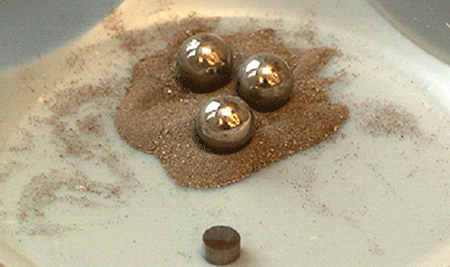MIT develops new powder tungsten-chromium-iron heavy alloy
January 19, 2015
Researchers at the Department of Materials Science and Engineering, Massachusetts Institute of Technology (MIT), Cambridge, USA, have reported the development of a new tungsten-chromium-iron Powder Metallurgy alloy that could replace depleted uranium and existing tungsten heavy metal alloys in armour-piercing projectiles.
The W-7Cr-9Fe alloy is reported to be significantly stronger than commercial tungsten heavy alloys showing a nanoindentation hardness of 21 GPa, which is about double the nanoindentation hardness of nanocrystalline iron-based alloys or coarse-grained tungsten.
The material is made by high-energy ball milling of the W-Cr-Fe powder mixture. This creates repeated shearing of the metal powders, with the shearing driving the alloying elements to intermix while competing thermally activated recovery processes allow the alloy to return to its equilibrium state.

A compacted metal alloy pellet sits next to as-milled tungsten chromium iron metal powders in a boat used for weighing the metals. The steel balls are used to deform the metals in a high-energy ball mill (Photo: Denis Paiste, Materials Processing Center MIT)
Zachary C Cordero reported the researchers’ results in a paper at the MIT Materials Day held in October, 2014, and in a paper published in the journal Metallurgical and Materials Transactions (Vol 45 No 8, 2014, 3609-3618). The paper proposed a simple model to predict chemistries in a given alloy that will form a solid solution, and validated it with experiments.
The improvement was achieved by compacting metal powders in a field-assisted sintering hot press, with the best result, measured by the fine grain structure and highest hardness, achieved at a processing time of one minute at 1200°C. Longer processing times and higher temperatures led to coarser grains and weaker mechanical performance.
“The way that I make my materials is with powder processing, where first we make nanocrystalline powder and then we consolidate it into a bulk object. But the challenge is that consolidation requires exposing the material to higher temperatures,” Cordero stated. Heating the alloys to high temperatures can cause the grains within the metal to enlarge, which weakens them. Cordero was able to achieve ultrafine grain structure of about 130 nanometers in the W-7Cr-9Fe compact, confirmed by electron micrographs.
“Using this powder processing route, we can make big samples up to two centimetres in diameter, or we could go bigger, with dynamic compressive strengths of 4 GPa. The fact that we can make these materials using a scalable process is maybe even more impressive,” added Cordero.















